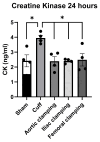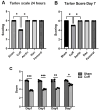Comparison of Different Animal Models in Hindlimb Functional Recovery after Acute Limb Ischemia-Reperfusion Injury
- PMID: 39335593
- PMCID: PMC11428748
- DOI: 10.3390/biomedicines12092079
Comparison of Different Animal Models in Hindlimb Functional Recovery after Acute Limb Ischemia-Reperfusion Injury
Abstract
Acute limb ischemia (ALI) is a sudden lack of blood flow to a limb, primarily caused by arterial embolism and thrombosis. Various experimental animal models, including non-invasive and invasive methods, have been developed and successfully used to induce limb ischemia-reperfusion injuries (L-IRI). However, there is no consensus on the methodologies used in animal models for L-IRI, particularly regarding the assessment of functional recovery. The present study aims to compare different approaches that induce L-IRI and determine the optimal animal model to study functional limb recovery. In this study, we applied a pneumatic cuff as a non-invasive method and ligated the aorta, iliac, or femoral artery as invasive methods to induce L-IRI. We have measured grip strength, motor function, creatine kinase level, inflammatory markers such as nuclear factor NF-κB, interleukin-6 (IL-6), hypoxia markers such as hypoxia-induced factor-1α (HIF-1α), and evaluated the muscle injury with hematoxylin and eosin (H&E) staining in Sprague Dawley rats after inducing L-IRI. The pneumatic pressure cuff method significantly decreased the muscle strength of the rats, causing the loss of ability to hold the grid and inducing significant limb function impairment, while artery ligations did not. We conclude from this study that the tourniquet cuff method could be ideal for studying functional recovery after L-IRI in the rat model.
Keywords: SD rat; aorta; artery; creatine kinase; femoral; grip strength; iliac; ligation; limb ischemia; motor function; muscle injury; pneumatic cuff.
Conflict of interest statement
The authors declare no conflicts of interest.
Figures





References
-
- Apichartpiyakul P., Shinlapawittayatorn K., Rerkasem K., Chattipakorn S.C., Chattipakorn N. Mechanisms and Interventions on Acute Lower Limb Ischemia/Reperfusion Injury: A Review and Insights from Cell to Clinical Investigations. Ann. Vasc. Surg. 2022;86:452–481. doi: 10.1016/j.avsg.2022.04.040. - DOI - PubMed
-
- Smith D.A., Lilie C.J. StatPearls. StatPearls Publishing LLC; Treasure Island, FL, USA: 2021. Acute Arterial Occlusion. - PubMed
-
- Aboyans V., Ricco J.B., Bartelink M.L., Björck M., Brodmann M., Cohner T., Collet J.P., Czerny M., De Carlo M., Debus S., et al. 2017 ESC Guidelines on the Diagnosis and Treatment of Peripheral Arterial Diseases, in collaboration with the European Society for Vascular Surgery (ESVS): Document covering atherosclerotic disease of extracranial carotid and vertebral, mesenteric, renal, upper and lower extremity arteriesEndorsed by: The European Stroke Organization (ESO)The Task Force for the Diagnosis and Treatment of Peripheral Arterial Diseases of the European Society of Cardiology (ESC) and of the European Society for Vascular Surgery (ESVS) Eur. Heart J. 2018;39:763–816. - PubMed
-
- Mustapha J.A., Katzen B.T., Neville R.F., Lookstein R.A., Zeller T., Miller L.E., Jaff M.R. Determinants of Long-Term Outcomes and Costs in the Management of Critical Limb Ischemia: A Population-Based Cohort Study. J. Am. Heart Assoc. 2018;7:e009724. doi: 10.1161/JAHA.118.009724. - DOI - PMC - PubMed
Grants and funding
LinkOut - more resources
Full Text Sources

